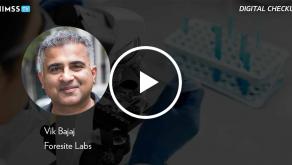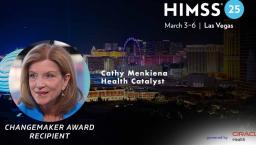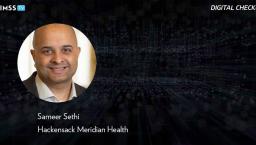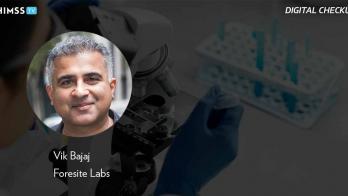How genAI can help solve major pain points in the rev cycle

Varun Ganapathi, cofounder and chief technology officer at Akasa
Photo: Akasa
Without accurate and reliable revenue cycle management, it's going to be very difficult to operate a successful hospital or health system. Accurate and reliable medical coding is a big part of this, as well.
A growing number of healthcare organizations see potential in artificial intelligence to increase revenue and relieve administrative burdens that reach all the way to the providers themselves. But medical coders worry about AI's accuracy and the future potential for job loss.
However, the goal should not be autonomy, but rather augmentation – instead of removing the human from the equation, the human can be empowered with new generative AI-powered assistive software, said Varun Ganapathi, cofounder and chief technology officer at Akasa, vendor of generative AI-based revenue cycle management technology. Ganapathi holds a doctorate in computer science, specializing in artificial intelligence, from Stanford University.
Healthcare IT News spoke with Ganapathi to get his insights into how genAI can be used in revenue cycle areas such as medical coding, how the technology can be trained to share justifications for its recommendations, what organizations need to consider when exploring generative AI systems and their underlying technology, best practices for genAI implementation specific to coding and revenue cycle processes, and how genAI-powered tools can help resolve revenue cycle workforce hurdles.
Q. How can genAI be used in revenue cycle areas such as medical coding? How would you caution users?
A. GenAI is the future of the revenue cycle. This complex industry depends on highly manual and time-consuming tasks that involve maneuvering around intricate EHRs and payer portals, dealing with endless documentation, and coping with ever-changing regulations and policies – all while trying to prioritize the patient experience.
GenAI is powered by large language models that deeply understand the patient records and comprehend clinical data previously opaque to computers. With LLMs, all of that is now accessible. Training an LLM to understand the healthcare domain and its data opens up many possibilities, including a more straightforward path to truly solving some of the major pain points in the revenue cycle.
Historically, coding has been too complex for most older technology to solve adequately. This isn't the case with genAI, which can be trained specifically on health systems' data. This allows the genAI to surface relevant information from patient data and workflows, as opposed to a massive online database.
From there, genAI can work in tandem with existing coding specialists, generating suggested quotes and codes. Because genAI runs on LLMs, it continues to learn, too. So, if coding rules update in a particular state or new patient data is added, genAI can quickly adapt.
Where users need to be cautious is with autonomous coding. While exciting as an idea, in execution, autonomous coding brings a number of risks, including inaccurate coding suggestions. This is why health systems should always use a trusted genAI model that is fine-tuned on their data and keeps humans involved in the process.
Q. You suggest showing work is critical when using genAI in the revenue cycle. Why? And how can the technology be trained to share justifications for its recommendations and insights?
A. Showing your homework is critical in healthcare, especially when working with genAI. Hallucinations, or genAI outputs that aren't accurately based on factual data, are a real concern. Imagine a tool suggesting false codes for a patient. What started as a routine visit could turn into massive medical bills and a misdiagnosis.
So much of AI has historically been a black box in which we can't see the technology working and can't understand where the results are coming from. With the right genAI tool, coders can see which coding suggestions are being made and why. Where in the patient records is the information coming from?
By showing its work, the genAI allows teams to then vet that suggestion before it reaches a payer for an accurate reimbursement. It trains on specific data, so it learns how to capture the most successful codes for each individual organization and case mix index.
Q. What do organizations need to consider when exploring generative AI systems and their underlying technology?
A. Organizations need to do some groundwork before implementing genAI. While genAI can learn on the fly and adapt to different workflows, it still requires some help getting off the ground.
First, health systems must have as much of their information digitized as possible. Again, you want genAI trained on the health system, data and workflows, and this can only happen if information is digital.
Next, it's essential any genAI tool works with the systems provided. Is it compatible with an organization's EHR? The provider portals used? Can it scale across service lines, even complex ones?
Lastly, but most important, organizations need to think about security. What's the genAI vendor's data retention policy? Do they conduct audits and encrypt all data? And the same goes for organizations. Is an organization encrypting data, running audits and only retaining what it has to?
Q. What are some best practices for genAI implementation specific to coding and revenue cycle processes?
A. It's easy for organizations to get excited about genAI, and even easier to want to streamline everything possible. Instead, look at the low-hanging fruit. What are the problem areas that aren't overwhelmingly massive and complex?
More importantly, which areas have the most data to train genAI? Those might be great areas to pilot the technology and prove results.
For instance, with coding, an organization can get more out of its team by using a genAI tool specializing in generating quotes and code suggestions. This can even help with having to loop in physicians for coding suggestions.
Q. And how can genAI-powered tools help resolve revenue cycle workforce hurdles, such as medical coder shortages?
A. There is a large shortage of medical coders right now. Seasoned coders are retiring, and not enough new people are entering the workforce. Coding teams need to do more with less. But how? Historically, technology has been the answer.
Workforce shortages lead to time pressure and asking coders to go faster than they would otherwise. This results in a lack of comprehensiveness because documents are skipped, or small details are missed. These details can lead to missing codes or incorrect codes, which ultimately can negatively impact quality metrics.
GenAI can help find codes that humans might otherwise miss. Some genAI models can review clinical records at a faster speed than staff can – and go deeper into the files – which results in greater accuracy and achieving appropriate revenue at a lower cost.
Some models suggest correct codes, leaving coders with the task of auditing or double-checking the work. This not only allows senior coders to spend less time on menial work, but also allows newer hires to operate at the speed of a seasoned coder.
Think of genAI as giving coders superpowers. It's helping them work faster and perform better. Now, imagine that kind of potential across an entire revenue cycle.
Follow Bill's HIT coverage on LinkedIn: Bill Siwicki
Email him: bsiwicki@himss.org
Healthcare IT News is a HIMSS Media publication.
























